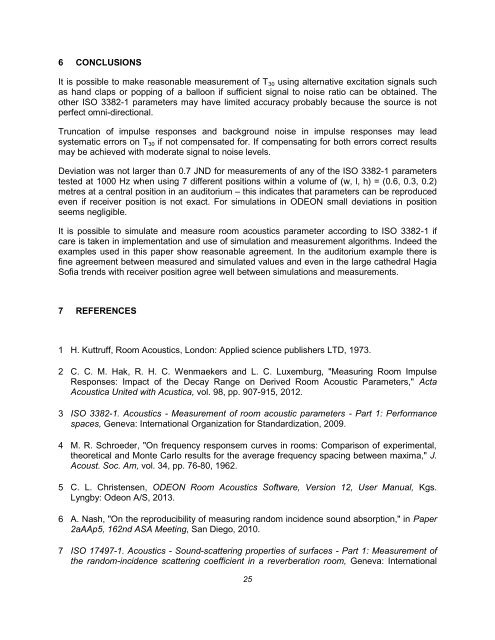paper - Odeon
paper - Odeon
paper - Odeon
Create successful ePaper yourself
Turn your PDF publications into a flip-book with our unique Google optimized e-Paper software.
6 CONCLUSIONS<br />
It is possible to make reasonable measurement of T 30 using alternative excitation signals such<br />
as hand claps or popping of a balloon if sufficient signal to noise ratio can be obtained. The<br />
other ISO 3382-1 parameters may have limited accuracy probably because the source is not<br />
perfect omni-directional.<br />
Truncation of impulse responses and background noise in impulse responses may lead<br />
systematic errors on T 30 if not compensated for. If compensating for both errors correct results<br />
may be achieved with moderate signal to noise levels.<br />
Deviation was not larger than 0.7 JND for measurements of any of the ISO 3382-1 parameters<br />
tested at 1000 Hz when using 7 different positions within a volume of (w, l, h) = (0.6, 0.3, 0.2)<br />
metres at a central position in an auditorium – this indicates that parameters can be reproduced<br />
even if receiver position is not exact. For simulations in ODEON small deviations in position<br />
seems negligible.<br />
It is possible to simulate and measure room acoustics parameter according to ISO 3382-1 if<br />
care is taken in implementation and use of simulation and measurement algorithms. Indeed the<br />
examples used in this <strong>paper</strong> show reasonable agreement. In the auditorium example there is<br />
fine agreement between measured and simulated values and even in the large cathedral Hagia<br />
Sofia trends with receiver position agree well between simulations and measurements.<br />
7 REFERENCES<br />
1 H. Kuttruff, Room Acoustics, London: Applied science publishers LTD, 1973.<br />
2 C. C. M. Hak, R. H. C. Wenmaekers and L. C. Luxemburg, "Measuring Room Impulse<br />
Responses: Impact of the Decay Range on Derived Room Acoustic Parameters," Acta<br />
Acoustica United with Acustica, vol. 98, pp. 907-915, 2012.<br />
3 ISO 3382-1. Acoustics - Measurement of room acoustic parameters - Part 1: Performance<br />
spaces, Geneva: International Organization for Standardization, 2009.<br />
4 M. R. Schroeder, "On frequency responsem curves in rooms: Comparison of experimental,<br />
theoretical and Monte Carlo results for the average frequency spacing between maxima," J.<br />
Acoust. Soc. Am, vol. 34, pp. 76-80, 1962.<br />
5 C. L. Christensen, ODEON Room Acoustics Software, Version 12, User Manual, Kgs.<br />
Lyngby: <strong>Odeon</strong> A/S, 2013.<br />
6 A. Nash, "On the reproducibility of measuring random incidence sound absorption," in Paper<br />
2aAAp5, 162nd ASA Meeting, San Diego, 2010.<br />
7 ISO 17497-1. Acoustics - Sound-scattering properties of surfaces - Part 1: Measurement of<br />
the random-incidence scattering coefficient in a reverberation room, Geneva: International<br />
25
















